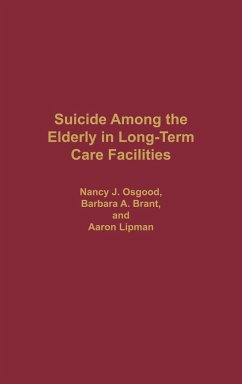This is the first large-scale study of suicide in a population of institutionalized older adults. From their findings, the authors identify the most at risk groups and highlight the major factors contributing to suicide in older adults in institutions. The study described in this work employed a sample survey design. More than 1000 administrators of long-term care facilities in the United States were randomly selected and surveyed about their staff and facilities, and the incidence and type of suicidal behaviors which occurred among residents in 1984 and 1985. Results of the study confirmed that suicidal behavior occurred in approximately 20 percent of the facilities who responded. High risk groups of residents included white males and the old-old (75 years and older). The survey reveals that certain environmental factors such as the size of the facility, staff turnover rate, per diem cost, and auspices (public, private, and religious) were related to the occurrence and outcome of suicidal behavior. Suggestions for suicide prevention, based on these findings, are also presented. The book is divided into three parts. Part One examines various types of long-term care facilities, including skilled nursing facilities, intermediate care facilities, and adult homes. Part Two highlights design, methodology, and findings from the national study of suicide in long-term care facilities. Case profiles of suicidal residents are included to provide a more personal account of suicide behavior, and to illustrate important factors in the older individual's decision to end her/his life. Case profiles of four institutions are also included to highlight environmental factors related to suicidal behavior. Part Three focuses on suicide prevention. Suggestions on the treatment of depression in the elderly, suicide prevention techniques, and the ethics of suicide are discussed in detail. This book makes valuable reading for professionals involved in the care of the elderly.
Hinweis: Dieser Artikel kann nur an eine deutsche Lieferadresse ausgeliefert werden.
Hinweis: Dieser Artikel kann nur an eine deutsche Lieferadresse ausgeliefert werden.








